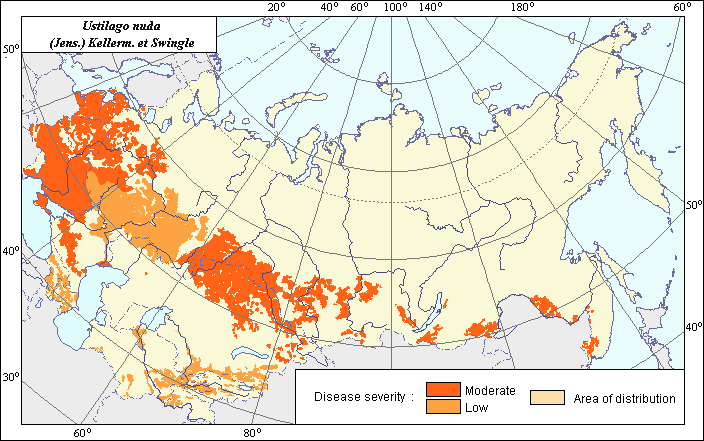Diseases
Area of the Barley Loose Smut (pathogen - Ustilago nuda (Jens.) Kellerm. et Swingle.)
 Object description Download GIS-layers
Object description Download GIS-layers
Authors:
Object specialist O.S. Afanasenko, GIS-specialist I.A. Budrevskaya.Date of creation:
10.03.2004.Scale:
1:20 000 000.Accuracy of map:
Map was created based on materials of maps of natural scale 1:33 000.000.Projection:
"Alber's Equal Area Conic", 9, 1001, 7, 100, 0, 44, 68, 0, 0.Basic contents:
Vector map. Area of species distribution and zones of disease severity are shown by polygons.Accuracy of classifier:
The map area is subdivided into zones of low and moderate severity. The disease is of greatest concern in Eastern and Western Siberia, Northern Caucasus, North-West and Central Regions of Non Chernozem Region, South Ural, Far East, also in Baltic region (Latvia, Lithuania) Belarus, Ukraine, Kazakhstan. The yield losses depend on disease development. With the frequency of disease occurrence at 0.7-4.7%, the losses can reach 22.3-31.6%. In the Ukraine yield losses are estimated at 14%. The zone of moderate harm was determined according to literature sources and is based on the frequency of disease occurrence greater than 1%, whereas, the zone of low harm is based on frequency less than 1% or when there is the presence of Ustilago nuda in the pathogen complex if there is no data on disease frequency. Local epiphytoties can take place in any agroclimatic zone at the infringement of agrotechnical norms (crops from non-treatment seeds). This is why it is impossible to designate a zone demonstrating the most frequent occurrences of epiphytoties.Method of map production:
Scientists were given maps with boundaries of Oblasts and arable lands. After reviewing historic literature, species distribution was hand drawn on maps. The general life-cycle information of the pathogen and host-plants was gathered from the following literature sources: Ishkova et al. (2000), Mathre (1997).The zones of disease severity were determined according to the following sources: Ishkova et al. (2000), Sanin (1995), Kirdoglo & Shevchenko (1986), Buidvis & Kokha (1975), Chumakov (1962), Kozhevnikova (1970), Oniskova (1989), Sanin (1995), Stepanovskikh (1970), Tikhomirov & Sidorova E.F. (1991), Tyunin & Kushnirenko (1981), Novozhilov & Zakharenko (2000). If data were on the Oblast-level, distribution is on the Oblast level. In some cases, Oblast.s are further refined by boundaries of the Arable Land Map (Koroljeva et al., 2003). Hand drawn maps were scanned, georeferenced and vectorized.
Reference citations:
Buidvis K.R., Kokha M.I. 1975. Studies of race composition of causal agent of Loose Smut Ustilago nuda (Jens.) Rostr. in barley fields in Latvian SSR. Izvestiya akademii nauk Latviiskoi SSR, 1: 25-29. (In Russian)Chumakov A.E. 1962. Forecasting distribution of main diseases of field cultures for 1962. Plant Protection against pests and diseases, 3:47-49. (In Russian)
Ishkova T.I., Berestetskaya L.I., Gasich E.L., Levitin M.M., Vlasov D.Yu. 2000. Diagnostic of the main diseases of cereals. Saint Petersburg: VIZR. 76 p. (In Russian)
Kirdoglo E.K., Shevchenko E.P. 1986. Level of harmfulness of Barley Loose Smut in Forest-steppe zone of Ukraine. In: Scientific-technical proceedings of All-Union Breeding and Genetic Institute. Odessa: VSEGEI. 59-61 pp. (In Russian)
Koroljeva IE, Vilchevskaya EV, Ruhovich DI. 2003. Digital Arable Land Map. Laboratory of Soil Information of the Dokuchaev Soil Institute, Moscow, Russia [Based on: Yanvareva LF. (ed.), Martynjuk KN., Kisileva NM. 1989. Map of Land Use, Faculty of Geography, Moscow State University, Moscow, Russia.].
Kozhevnikova L.M. 1970. Species of Barley Loose Smut in Voronezh Region. Plant Protection against pests and diseases, 2: 19-20. (In Russian)
Mathre D.E., ed. 1997. Compendium of barley diseases. St. Paul, Minnesota: APS PRESS. 90 p.
Novozhilov K.V., Zakharenko V.A., eds. 2000. Levels and tendencies of variability of species composition and intrapopulation structure, areas of complexes of harmful and useful organisms and forecast of dangerous phytosanitary situations in zones of the country. St. Petersburg: VIZR. 100 p. (In Russian)
Oniskova M.G. 1989. Distribution and specialization of races of causal agent of barley loose smut in the North Kazakhstan. In: Proceedings of the Theoretical bases of agricultural culture breeding in North Kazakhstan. Tselinograd. 74-76 pp. (In Russian)
Sanin S.S. 1995. Phytosanitary monitoring: modern state and ways of improvement. In: Problems of Optimization of Phytosanitary State in Plant Industry. Proceedings of All-Russian Meeting on Plant Protection. St. Petersburg: VIZR. 166-175 pp. (In Russian)
Stepanovskikh A.S. 1970. Studies of species structure of Barley Loose Smut in virgin region, Kurgan and Chelyabinsk Regions. In: Proceedings of Kurgan Agricultural Institute, Plant Protection of Agricultural Cultures Against Pests and Diseases. Kurgan: KSKhI. 17-26 pp. (In Russian)
Tikhomirov V.T., Sidorova E.F. 1991. Resistance of spring barley to Loose Smut in Eastern Siberia and ways of it's improving. Siberian Vestnik of Agricultural Science, 5: 55-58. (In Russian)
Tyunin V.A., Kushnirenko I.U. 1981. Species structure and distribution of causal agents of Barley loose Smut in Chelyabinsk Region. In: Regional Systems of Plant Protection Against Pests and Diseases in Siberia. Novosibirsk. 29-31 pp. (In Russian)

